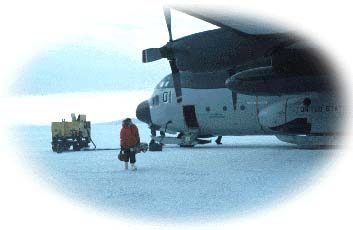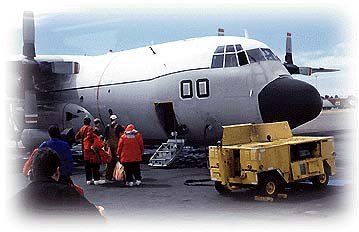
|
Overview In this activity students experiment with the relationship between pressure, force, and area. They determine the force and pressure exerted by a LC-130 on the McMurdo ice runway. LC-130's commonly are used for cargo and personnel transport in Antarctica. This activity includes components of a classroom activity originally written by Carole Bennett and later modified by her for inclusion in the National Science & Technology Week 1998 resource guide "Polar Connections"  Arrival at Williams Field, McMurdo Station. Photograph by S. Shipp, Rice University. Rationale Designing an airstrip on land is challenging. Designing airstrip on ice adds a few wrinkles. And to further complicate the engineering, make that ice a floating ice shelf! Engineers working on the runways for the huge and heavy LC-130's landing near McMurdo had their work cut out for them! The engineers must know the pressure exerted by the LC-130's on the runway to know if the planes can land safely. A mistake can mean that the plane and cargo break through the ice and end up in the cold ocean below the ice shelf. Grade Level/Discipline High School, Physical Science, Physics, Chemistry Introduction to the Gas Laws Objectives Students will: National Standards Teacher Preparation for Activity Before class, prepare one pan of sand for each group of 4 to 5 students. Pour fine sand into the pan so that each pan has 5 to 10 centimeters of sand in the bottom. Add enough water to dampen, but not soak the sand. There should be no standing water in the pan. The sand should be damp enough such that a finger can be poked into the sand and the hole remains intact when the finger is removed. Materials For the teacher: For each group of 4 to 5 students: Time Frame 1 class period Teaching Sequence
Engagement and Exploration (Student Inquiry Activity)
Area of wheels where they touch the ice: 2 main wheels 23 inches x 25 inches each nose wheel 15 inches x 12 inches Area of skis: 2 main skis and 1 nose ski (20 inches x 62 inches each) Which should be used to land on sea ice? Why?
155,000 lb. Area of wheels where they touch the ice: 2 main wheels 23”x 25” + nose wheel 15”x 12” = 1330 in2 Area of skis: 2 main skis and 1 nose ski ( 20” x 62” each) = 3720 in2 Pressure under wheels 155,000 / 1330 = 116.5 psi Pressure under skis 155,000 / 3720 = 41.7 psi As the ice softens in summer, the ice is unable to withstand the pressure exerted by the wheels and the planes must be adapted to skis. What does this mean for the use of the equation: Pressure = Force/Area? The skis have a greater area than the tires. By using skis the pressure is less than half of the former pressure (if they do not reduce the load; in reality, the load of the LC-130's must be lessened by 8000 lb. for ski use, so the actual pressure is 147,000 lb. / 3720 in2 = 39.5 psi). Extensions This activity can be modified by having the students think what the pressure must be in the tires of the family car (at least 86.6 psi). Before the class begins the activity, ask the students to estimate the weight of the family car, the area of tire in contact with the ground, the pressure of each tire. Have the students note their estimates for later comparison. For homework, ask the students to:
2. Determine the pressure in EACH tire using a tire gauge.
4. Add all the forces (weights) and compare with the manual. It usually is pretty close. Evaluation (Assessing Student Performance) Authors Carole Bennett, Gaither High School, Tampa, Florida; TEA - 1996 Background LC-130's are the four-engine turboprop transport aircraft used by the United States Antarctic Program for transport between New Zealand and McMurdo Station and between McMurdo Station and Amundsen-Scott South Pole Station.  Boarding a LC-130 bound for Antarctica. Wearing the issued cold-weather gear is required; the flight will get chilly, and the clothing is an added safety precaution. Photograph by S. Shipp, Rice University. The LC-130's are C-130's that have been modified for polar use. They are equipped with skis and designed for landing on snow and ice. LC-130's can carry approximately 27,000 pounds of cargo and personnel (don't be fooled - personnel are considered cargo!). The planes carry enough fuel to travel from Christchurch, New Zealand to McMurdo Station - one way! LC-130's are capable of flying from McMurdo to the South Pole without refueling. Once at the South Pole, the engines are never shut down to prevent mechanical failures. Flights between McMurdo and South Pole are frequent from late October to mid-February; the station is isolated at all other times! 
Cargo strapped into the LC-130 for the trip to McMurdo Station includes Philip Bart and Mark Herring of Rice University, Jordan Franceschini and Martin Hilfinger of Hamilton College, and Kathy Licht and Jiang Xiao of the University of Colorado. Photograph by S. Shipp, Rice University. At McMurdo Station, the LC-130's land either on a sea-ice runway if the temperatures are sufficiently cold (from October into December), or on one of two strips, Williams Field or the Pegasus Runway. Williams Field ("Willie Field" to the locals) is used by ski-equipped planes. Landings are a little bumpy! Pegasus is a harder, smoother ice runway that is used by wheeled aircraft. In the summer, temperatures warm enough to make the Pegasus runway unusable. Resources Student Reproducible Masters We look forward to hearing from you! Please review this activity.Return to top of page Back to: TEA Activities Page |
